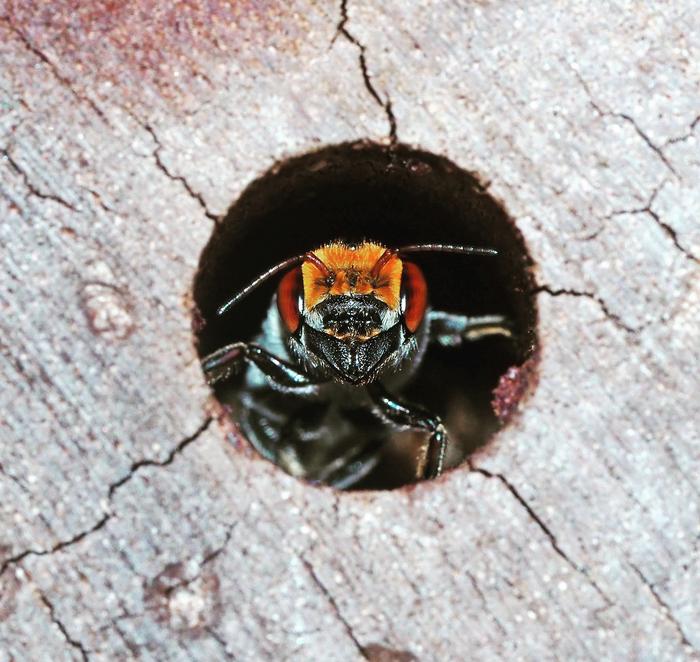New research from Curtin University has uncovered alarming evidence that high densities of introduced European honey bees may profoundly impair the reproductive success and overall fitness of native Australian bees. This emerging ecological concern highlights the complex interactions between invasive species and endemic pollinators, raising urgent questions about biodiversity conservation and ecosystem management in urban and semi-natural environments.
Led by Adjunct Research Fellow Dr Kit Prendergast from Curtin’s School of Molecular and Life Sciences, the study employed innovative, purpose-built wooden ‘bee hotels’ positioned across fourteen carefully selected urban bushland and garden sites throughout Perth, Western Australia. These structures served as standardized nesting habitats, enabling precise monitoring of native cavity-nesting bee populations and their reproductive outcomes relative to varying local densities of honey bees.
Intriguingly, the research spanned two consecutive Spring-to-Summer bee seasons, encompassing the active reproductive periods for many species. Over the course of the study, an extensive dataset was gathered from approximately 1000 native bee nests, representing at least 25 distinct species. This large sample provided unprecedented resolution to analyze how interspecific competition with honey bees impacts native bees’ reproductive traits and survival metrics.
Findings revealed a striking pattern: in sites with higher densities of European honey bees, native bees produced significantly fewer female offspring, exhibited increased brood mortality rates, and the males that successfully emerged were consistently smaller in size. Collectively, these changes indicate a marked decrease in the fitness of native bee populations, with profound implications for their long-term viability and ecological roles as pollinators.
The mechanisms underlying these effects appear linked to resource competition, particularly for pollen. Pollen analysis showed that honey bees exploited a broader and more diverse range of floral resources, including exotic plant species that are often introduced into urban landscapes. This wider foraging breadth gives honey bees a competitive advantage, leading to heightened overlap with native bees for limited pollen sources.
Notably, the research demonstrated that greater overlap in pollen use between honey bees and native bees corresponded with reduced offspring production in native species. This phenomenon suggests that resource depletion by honey bees may directly restrict the quantity and quality of provisions available for native bee larvae, thereby compromising their development and survival prospects.
Beyond the competition for pollen, the study raises broader ecological concerns about how introduced honey bees may alter the dynamics of native pollinator communities. Reduced fitness in native bees could cascade into diminished pollination services for endemic plants, potentially destabilizing urban and peri-urban ecosystems that rely on a diverse assemblage of pollinators for resilience.
Crucially, Dr Prendergast emphasized that ‘bee hotels’ are not merely artificial nesting spaces but powerful research instruments that afford insights into the subtle and often hidden impacts of environmental pressures on native bees. By enabling systematic and repeatable sampling, these installations provide critical data that would be challenging to obtain through natural nests alone, given their often inaccessible or cryptic locations.
The study advocates for careful management of honey bee densities, especially in habitats of high conservation value or where native pollinators are already stressed by urbanization, habitat fragmentation, or environmental change. Until now, introduced honey bees have frequently been presumed to coexist benignly with native fauna, but these new findings challenge that assumption by demonstrating tangible, detrimental effects on indigenous bee health.
Looking forward, Dr Prendergast suggests that future research should investigate strategies to mitigate honey bees’ negative impacts, such as adjusting their population densities or enhancing floral diversity to support a wider array of pollinators. Increasing the availability of native flowering plants might reduce direct competition and foster coexistence among pollinator species.
This research forms an essential contribution to the growing body of evidence underscoring the complex ecological consequences of species introductions. It highlights the urgency for developing nuanced, science-based policies that balance the benefits of managed honey bees with the imperative to preserve native biodiversity and ecosystem function.
The study, which forms part of Dr Prendergast’s doctoral work, was supported by funding from the City of Stirling, the Australian Wildlife Society, Hesperia, and the Forrest Research Foundation. Its full details are published in the journal Frontiers in Bee Science, shedding light on a critical but often overlooked dimension of urban ecology and conservation.
Subject of Research: Animals
Article Title: Introduced honey bees have the potential to reduce fitness of cavity-nesting native bees in terms of a male bias sex ratio, brood mortality and reduced reproduction
News Publication Date: 19-May-2025
Web References: https://www.frontiersin.org/journals/bee-science/articles/10.3389/frbee.2025.1508958/abstract
Image Credits: Dr Kit Prendergast
Keywords: Life sciences, Bees, Insects, Arthropods, Animals




